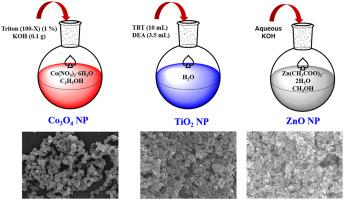Journal of Environmental Chemical Engineering ( IF 7.4 ) Pub Date : 2020-12-02 , DOI: 10.1016/j.jece.2020.104852 Iqra Rabani , Chinna Bathula , Rabia Zafar , Gul Zari Rabani , Sajjad Hussain , Supriya A. Patil , Young Soo Seo

|
The efficient removal of organic effluent from the water has attracted greater attention globally and continue to be major challenge for the environmental welfare. In the present study, we synthesized nanosized particles of Co3O4, TiO2 and ZnO via a facile sol-gel reaction and explored for the photocatalysis application. The obtained nanosized particles were characterized by the aid of XRD, FESEM, BET Raman and XPS spectroscopy. The influence of the surface modification of nanosized particles on photocatalytic degradation of multiple organic dyes such as methyl blue (MB) and rhodamine B (RB) have been examined. More than 95% of MB and RB degradation dyes with ZnO nanosized particles were noticed after subjecting to the UV illuminations for 40 m and 35 min, respectively. Nanosized ZnO particles exhibited the significantly higher photocatalytic performance than that of the TiO2 and Co3O4 nanosized particles due to the larger surface area (⁓36 m2/g) and smaller particle size (⁓8.9 nm). Additionally, the higher photocatalytic activity of the ZnO NPs might be attributed to the lower e–/h+ pair recombination (narrow bandgap; 3.01 eV) as well as greater photon absorption and dyes were degraded through the photocatalytic oxidation reaction (verified by the trapping active species experiment). Our study demonstrates the ZnO as attractive photocatalyst due to its remarkable stability, cost-effectiveness and eco-friendly reusable property to replace other metal oxides for certain catalytic applications.
中文翻译:

形态工程化的金属氧化物通过降解机理增强了从水中去除多种污染物的能力
从水中有效去除有机废水已引起全球的广泛关注,并且仍然是对环境福利的重大挑战。在本研究中,我们合成了Co 3 O 4,TiO 2纳米颗粒ZnO和ZnO可以通过简单的溶胶-凝胶反应进行光催化应用。借助XRD,FESEM,BET拉曼光谱和XPS光谱对获得的纳米级颗粒进行表征。纳米颗粒的表面改性对多种有机染料如甲基蓝(MB)和若丹明B(RB)的光催化降解的影响已得到检验。在分别经受40 m和35 min的紫外线照射后,发现具有ZnO纳米颗粒的MB和RB降解染料分别超过95%。氧化锌纳米颗粒表现出比TiO 2的显著较高的光催化性能2和Co 3 ö 4级纳米由于较大的表面积的颗粒(⁓36米2/ g)和较小的粒径(⁓8.9nm)。另外,在ZnO纳米颗粒的较高的光催化活性可能归因于较低ë - / H +对重组(窄带隙; 3.01电子伏特)以及更大的光子吸收和染料是通过光催化氧化反应劣化(由俘获验证活动物种实验)。我们的研究表明,由于ZnO具有出色的稳定性,成本效益和生态友好的可重复使用特性,可以代替某些催化剂的其他金属氧化物,因此具有诱人的光催化作用。











































 京公网安备 11010802027423号
京公网安备 11010802027423号